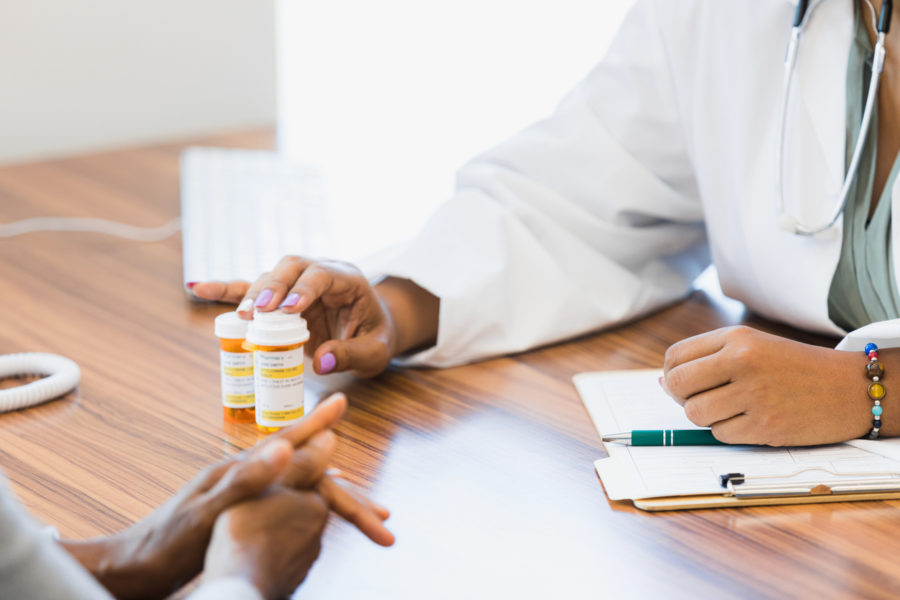What Causes Medication Errors at Pharmacies?
Every year, 7,000 to 9,000 people in the United States die due to medication errors. Additionally, hundreds of thousands of U.S. patients experience injuries due to erroneous medication administration or distribution. These adverse drug events can occur when patients receive the wrong dose or drug.
The question is, what causes medication errors? Join us as we explore several common reasons for these mistakes. We’ll also dive into point-of-care medication dispensing and the role it plays in preventing patient harm.
Introduction to Medication Errors
A medication error occurs whenever a patient receives the wrong prescription. Medication errors can happen during inpatient care, such as when a person is admitted to the intensive care unit (ICU) or during the medication dispensing process at pharmacies.
These errors can range from minor oversights with little to no impact on the patient to major mistakes that can lead to severe health complications or even fatalities. Some of the basic types of medication errors include:
Underdosing
Underdosing is perhaps the least dangerous type of medication error. In this scenario, the patient receives the right medication, but they receive less of it than they should. The impact of this mistake varies based on the importance of the medication and individual patient risk factors.
For instance, underdosing an antibiotic may allow a bacterial infection to run rampant, drastically worsening patient outcomes. Conversely, underdosing a prescription pain medication may have minimal impacts.
Overdosing
Overdosing can occur both when prescribing medications and administering drugs in health care settings. Either instance can be incredibly dangerous to the patient, especially when drugs are given intravenously, as they will have a rapid onset.
Overdosing is particularly dangerous in the pediatric setting, as most drugs are weight-based. However, adults can also suffer severe harm if they take too much medication. Fortunately, the dosage amounts of many drugs, including controlled substances, are administered in standardized increments. This practice helps reduce the likelihood of overdosing patients.
Providing the Wrong Medication
Many drug names sound alike, especially when using their abbreviations. Unfortunately, medication names that sound or look alike can cause patients to receive the wrong medication. Distributing the wrong meds has the potential to yield some of the most severe side effects.
Medication education can help prevent these types of errors. When you invest in patient education, you ensure that medication recipients know what types of drugs they should be receiving. As such, they can provide an extra layer of redundancy for preventing prescribing errors.
Another possible cause of this issue is linked to a poor understanding of medication repackaging guidelines. Make sure that your suppliers and pharmacy partners strictly adhere to repackaging rules, including those about labeling.
Medication Administration Errors
Medication administration errors occur when healthcare workers provide the wrong types of medications in a healthcare setting. There are several types of administration errors, including:
- Underdosing
- Overdosing
- Providing the wrong medication
- Administering medications with drug interactions
Healthcare providers must be extremely cautious during drug administration, especially when performing medical care in the emergency department. In these instances, healthcare professionals are often providing life-saving measures, which may involve rapidly administering multiple medications as well as other interventions.
Common Causes of Medication Errors
The most common reasons for medication errors include:
Misinterpretation of Prescriptions
Healthcare providers who use handwritten prescriptions must ensure that their handwriting is legible. Illegible handwriting can result in medication fulfillment delays or, worse, prescription errors. The easy solution to this problem is to transition to an electronic system.
Establishing an electronic reporting system will reduce error rates and allow you to easily disseminate prescription data to pharmacists. However, electronic medication orders aren’t foolproof.
If you want to maximize error reduction when using electronic prescription systems, make sure that you avoid abbreviations and type out the full names of medications. This is especially important when dealing with high-risk drugs. Also, avoid unclear instructions, and be very detailed regarding dosages and frequency. It’s imperative that you don’t leave anything to chance or interpretation.
Similar-Sounding Medications
Look-alike, sound-alike (LASA) medications are notorious for causing confusion among pharm teams. Medications with similar names or packaging can be mixed up easily, leading to patients receiving the wrong medications. This issue underscores the need for careful attention to detail and the implementation of checks to distinguish between such medications effectively.
These drugs have names that sound similar when spoken, or they look alike in written form, especially on handwritten prescription slips. For example, the sedative “lorazepam” and the antipsychotic “olanzapine” sound similar, increasing the risk of mix-ups. Imagine how similar these drugs would appear on a hastily written prescription slip.
Similarly, “hydroxyzine,” used to treat itching and anxiety, and “hydralazine,” a medication for high blood pressure, have names that can easily be confused. Addressing these risks requires heightened awareness and strategies to differentiate these medications clearly.
During dispensing, staff should use medication reconciliation strategies to perform a second phase of verification. This is especially important with high-alert medications, such as controlled substances and drugs with a high propensity to cause adverse effects.
High Workload and Fatigue
One of the major reasons for medication errors is pharmacist fatigue. The pharmaceutical dispensing sector is experiencing a high workload and a nationwide staff shortage. This combination of circumstances has created a perfect storm, opening the door for poor communication, erroneous order entry, and an increase in dispensing of the wrong medication.
There is also a large shortage of pharmacy techs. In a 2022 survey, 81% of respondents reported problems with finding enough pharmacy technicians to fill vacant positions. As you can imagine, all these shortages are placing added strain on pharmacy workers and increasing the likelihood of errors.
Lack of Communication
Inadequate communication between healthcare providers, including doctors, nurses, and pharmacists, can lead to medication errors. Clear and effective communication is essential for accurate medication management, ensuring that all parties have a consistent understanding of a patient’s medication regimen.
Consider how your practice relays prescriptions and patient information. Is your current process standardized across all pharmacies, or do you have to use a different approach with each pharmaceutical partner? A lack of standardized communication workflows increases the prevalence of near misses and outright medication errors.
Technology Issues
While technology plays a critical role in modern healthcare, overreliance on electronic health records or dispensing systems can introduce its own set of problems. Glitches or errors in these systems can lead to incorrect medication being prescribed or dispensed, highlighting the need for ongoing vigilance and verification processes.
Remember, too, that healthcare systems still rely on human inputs. If parties at either end of the transaction make a mistake, it can increase the incidence of error. Therefore, training your team and implementing checks and balances are crucial steps. By establishing layers of redundancy and verification, you increase your odds of catching any errors that enter your system.
Preventing Medication Errors With Physician Dispensing
With the question, “What causes medication errors?” now answered, it’s time to shift our attention to in-office dispensing. How can this process elevate patient care in your practice?
The advent of physician dispensing is a transformative approach in the healthcare sector, aiming to significantly reduce medication errors while enhancing patient safety and the overall efficiency of your practice. This model involves healthcare providers directly dispensing medications to patients, thereby playing a pivotal role in ensuring accuracy from prescription to patient receipt.
Below, we delve into how in-office dispensing acts as a pivotal strategy for mitigating medication errors, streamlining the medication process, and implementing preventive measures.
Role of Physician Dispensing
Understanding the reasons for medication errors is the first step in preventing them. Many errors can be directly linked to the flow of information between your office and the pharmacy. When you bring both aspects of the medication distribution process under one roof, you significantly reduce the risk of miscommunication.
Physician dispensing directly involves you in the medication dispensing process. In doing so, it allows for a more integrated approach to patient care.
In particular, this direct involvement eliminates several transitional steps where errors are prone to occur, such as during the transcription of prescriptions or the interpretation of handwritten notes by pharmacists. If one of your team members has a question about the medications you’ve ordered, they can simply walk down the hall and ask.
Offering medications in-house can also enhance patient safety. Direct dispensing provides you with an immediate and comprehensive overview of the patient’s medication regimen, enabling you to identify any potential drug interactions or contraindications. This oversight ensures that medications dispensed directly from you to the patient are as safe and effective as possible.
Getting started with in-office medication fulfillment is easier than you might expect, thanks to physician dispensing companies like Proficient Rx. Our team provides support and software designed to help you add this incredibly valuable service to your business model and better serve your patients.
Streamlining the Medication Process
Physician dispensing also offers substantial efficiency gains in the medication management process. Direct provider-to-patient dispensing simplifies the traditional pharmacy model, which is often ridden with bottlenecks such as insurance approvals, miscommunications, and prescription verification.
By streamlining these processes, you can provide a more seamless and efficient transfer of medications to patients. This, in turn, helps to reduce wait times and increases adherence.
Imagine two scenarios in which you are treating a patient for a serious bacterial infection. In scenario one, you rely on the traditional pharmacy model to fill prescriptions. However, the pharmacy cannot fulfill the prescription that day due to verification issues. As a result, the patient does not get their medications for another 24 hours, which allows their symptoms to worsen.
In scenario two, you have implemented an in-office dispensing program. As a result, the patient receives their antibiotics during their appointment and can start the treatment protocol within a few hours of seeing your team.
As you can see, there is a huge advantage to fulfilling prescription orders internally. However, that’s just one benefit. In-house dispensing also assists you by creating a secondary revenue stream for your office.
Implementing Preventive Measures
Under the traditional pharmacy model, you are at the mercy of the dispenser. While many pharmacies have stringent preventive measures to protect patients, others are not as diligent. In-house dispensing takes this variable off the table, giving you full control over which preventive measures are in place, including medication expiration date guidelines and repackaging protocols.
Strategies you can implement include patient counseling, medication reconciliation, and adherence monitoring, which become more integrated into the care process. During follow-up appointments, your team can verify that patients took their drugs as prescribed. You’ll also have the opportunity to address any adherence concerns that may negatively impact patient outcomes.
Patient counseling is also a critical component. It allows your staff to educate patients on their medications, including how and when to take them, potential side effects, and how to store them safely. This direct interaction ensures that your patients are well-informed about their treatment, which can significantly improve medication adherence and reduce the likelihood of errors.
Medication reconciliation is another preventive measure that becomes more effective when you are directly involved in dispensing. This practice involves verifying the patient’s medication information across all transitions of care to prevent discrepancies.
With physician dispensing, you can ensure that the medications provided are consistent with the patient’s current treatment regimen. This reduces the risk of harmful interactions or duplications.
Maximize Patient Safety With In-Office Dispensing
Physician dispensing represents a significant paradigm shift in medication management. It offers a comprehensive strategy for mitigating medication errors, streamlining the medication process, and implementing effective preventive measures.
By ensuring your direct involvement, you can enhance efficiency and provide a more informed and centralized treatment journey. In turn, this may lead to better patient outcomes and higher satisfaction.
Are you ready to learn more about how in-office dispensing works? Proficient Rx can provide you with resources and technologies designed to elevate medication safety through in-office dispensing. Contact us to discuss the needs of your practice.




